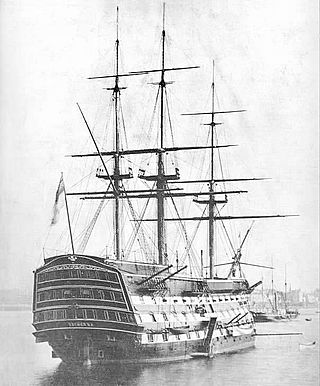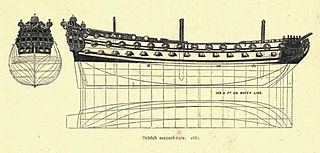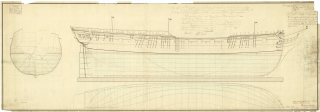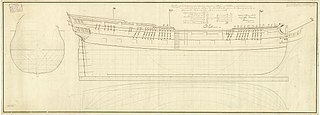
In the rating system of the Royal Navy, a third rate was a ship of the line which from the 1720s mounted between 64 and 80 guns, typically built with two gun decks. Years of experience proved that the third rate ships embodied the best compromise between sailing ability, firepower, and cost. So, while first-rates and second-rates were both larger and more powerful, third-rate ships were the optimal configuration.

In the rating system of the British Royal Navy used to categorise sailing warships, a first rate was the designation for the largest ships of the line. Originating in the Jacobean era with the designation of Ships Royal capable of carrying at least 400 men, the size and establishment of first-rates evolved over the following 250 years to eventually denote ships of the line carrying at least 80 guns across three gundecks. By the end of the eighteenth century, a first-rate carried no fewer than 100 guns and more than 850 crew, and had a measurement (burthen) tonnage of some 2,000 tons.

In the 18th century and most of the 19th, a sloop-of-war in the Royal Navy was a warship with a single gun deck that carried up to eighteen guns. The rating system covered all vessels with 20 guns and above; thus, the term sloop-of-war encompassed all the unrated combat vessels, including the very small gun-brigs and cutters. In technical terms, even the more specialised bomb vessels and fireships were classed as sloops-of-war, and in practice these were employed in the sloop role when not carrying out their specialised functions.

In the rating system of the Royal Navy used to categorise sailing warships, a second-rate was a ship of the line which by the start of the 18th century mounted 90 to 98 guns on three gun decks; earlier 17th-century second rates had fewer guns and were originally two-deckers or had only partially armed third gun decks. A "second rate" was the second largest class of warships in a hierarchical system of six "ratings" based on size and firepower.

In the rating system of the Royal Navy used to categorise sailing warships, a fifth rate was the second-smallest class of warships in a hierarchical system of six "ratings" based on size and firepower.

In the rating system of the Royal Navy used to categorise sailing warships, a sixth-rate was the designation for small warships mounting between 20 and 28 carriage-mounted guns on a single deck, sometimes with smaller guns on the upper works and sometimes without. It thus encompassed ships with up to 30 guns in all. In the first half of the 18th century the main battery guns were 6-pounders, but by mid-century these were supplanted by 9-pounders. 28-gun sixth rates were classed as frigates, those smaller as 'post ships', indicating that they were still commanded by a full ('post') captain, as opposed to sloops of 18 guns and less under commanders.

The rating system of the Royal Navy and its predecessors was used by the Royal Navy between the beginning of the 17th century and the middle of the 19th century to categorise sailing warships, initially classing them according to their assigned complement of men, and later according to the number of their carriage-mounted guns. The rating system of the Royal Navy formally came to an end in the late 19th century by declaration of the Admiralty. The main cause behind this declaration focused on new types of gun, the introduction of steam propulsion and the use of iron and steel armour which made rating ships by the number of guns obsolete.
HMS Leander was a 50-gun spar-decked frigate of the Royal Navy which saw service in the Napoleonic Wars, the War of 1812, and the Second Barbary War.

HMS Cornwall was a 74-gun third-rate Vengeur-class ship of the line built for the Royal Navy in the 1810s. She spent most of her service in reserve and was converted into a reformatory and a school ship in her later years. The ship was broken up in 1875.

HMS St Lawrence was a 102-gun first-rate wooden warship of the Royal Navy that served on Lake Ontario during the War of 1812. Built on the lake at the Royal Navy dockyard in Kingston, Ontario, she was the only Royal Navy ship of the line ever to be launched and operated entirely in fresh water. Constructed in 1814, the ship's arrival on the lake ended all naval action and St Lawrence finished the war having never gone into battle. Following the war, the vessel was laid up, eventually being sold in 1832 to private interests. The ship was later sunk and is now a recreational dive spot.

HMS Gloucester was a 74-gun, third rate Vengeur-class ship of the line built for the Royal Navy in the 1810s. She played a minor role in the Napoleonic Wars and was cut down into a 50-gun fourth rate frigate in 1831–32. The ship was converted into a receiving ship and broken up in 1884.

HMS Colossus was a 80-gun second rate Vanguard-class ship of the line built for the Royal Navy in the 1840s. The ship was fitted with steam propulsion in 1854–1855, and was sold for scrap in 1867.
HMS Falmouth was a 50-gun fourth-rate ship of the line built for the Royal Navy in the first decade of the 18th century. The ship participated in several battles during the War of the Spanish Succession (1701–15) and the War of Jenkins' Ear (1739–48).

HMS Milan was a 38-gun fifth rate frigate of the Royal Navy. She had previously been Ville de Milan, a 40-gun frigate of the French Navy, but served for only a year before being chased down and engaged by the smaller 32-gun frigate HMS Cleopatra. Ville de Milan defeated and captured her opponent, but suffered so much damage that she was forced to surrender without a fight several days later when both ships encountered HMS Leander, a British fourth rate. Milan went on to serve with the Royal Navy for another ten years, before being broken up in 1815, after the conclusion of the Napoleonic Wars.

HMS Chatham was a 74-gun third-rate ship of the line of the Royal Navy. She had been planned as Royal-Hollandais for the French Navy, but was captured while under construction during the Walcheren Campaign.

Post ship was a designation used in the Royal Navy during the second half of the 18th century and the Napoleonic Wars to describe a ship of the sixth rate that was smaller than a frigate, but by virtue of being a rated ship, had to have as its captain a post captain rather than a lieutenant or commander. Thus ships with 20 to 26 guns were post ships, though this situation changed after 1817.

The Artois class were a series of nine frigates built to a 1793 design by Sir John Henslow, which served in the Royal Navy during the French Revolutionary and Napoleonic Wars.

HMS Arethusa was a 46-gun Leda-class fifth-rate frigate built for the Royal Navy during the 1810s. The ship was never commissioned and was converted into a lazarette in 1836. She was renamed HMS Bacchus in 1844 and was further converted into a coal hulk in 1851–52. The ship was sold for scrap in 1883.

HMS Talbot was a 28-gun Atholl-class sixth-rate frigate built for the Royal Navy during the 1820s.

HMS Cato was a 50-gun Grampus-class fourth rate ship of the Royal Navy. One of a class of ships constructed for service in the American Revolutionary War, Cato was commissioned in 1782. She became the flagship of Sir Hyde Parker, and sailed with him to the East Indies Station later in the year. After stopping at Rio De Janeiro on 12 December, the ship sailed for the Cape of Good Hope and was never seen again. Theories on her disappearance include her being shipwrecked in locations such as the Malabar Coast and the Maldives, and the crew being murdered by natives. Sir John Knox Laughton argues that it is more likely that Cato caught fire and blew up at sea.



















